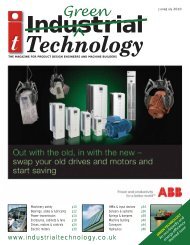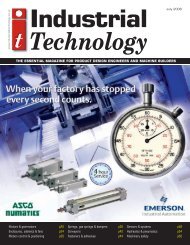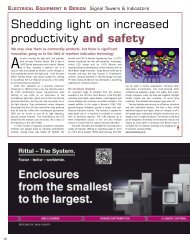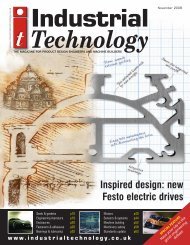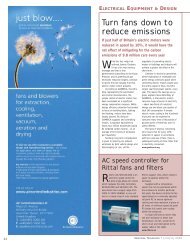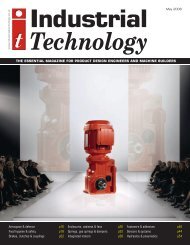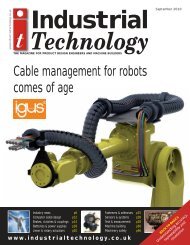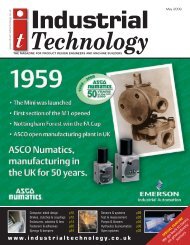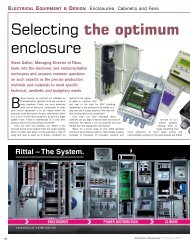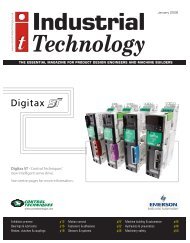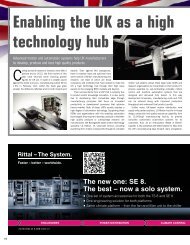machine building & automation - Industrial Technology Magazine
machine building & automation - Industrial Technology Magazine
machine building & automation - Industrial Technology Magazine
- No tags were found...
Create successful ePaper yourself
Turn your PDF publications into a flip-book with our unique Google optimized e-Paper software.
MACHINE BUILDING & AUTOMATIONMachine Control PLCsMaking the most of<strong>machine</strong> control PLCsToday’s PLCs can bring a raft of benefits to boththe <strong>machine</strong> designer and end user. We spoke tothe leading vendors, and asked their opinions onwhat can be achieved today, and what we canexpect from <strong>machine</strong> control in the futureBack in the early 1970s whenPLCs first became accepted asthe way to automate a <strong>machine</strong>or process, very few users wouldhave considered the cost of developingthe ‘logic control’ software as part of theoverall <strong>machine</strong> cost. In fact, it isestimated that in 1970, the cost of theman hours to write the <strong>machine</strong> controlcode accounted for just 1-2% of theoverall cost.As the capabilities of traditional PLCshave expanded to meet the demands ofthe OEM <strong>machine</strong> builders and their endusercustomers, such as the inclusion ofcomplex motion control, integrated safetyand vision inspection, and data storageand manipulation, so the cost of softwaredeveloped has also increasedproportionally. Even just a decade ago, upto 40% of the cost of any <strong>machine</strong> wasattributable to the cost of its controlsoftware development. Today, that figure islikely to be even higher.Of course, it is not just the complexityof <strong>machine</strong>s that has changed over theyears, as Omron’s Karl Walker explains:“Flexibility and re-configurability havebecome top priorities for OEMs. Theevidence of this is the ever-increasingnumber of servo axes per <strong>machine</strong>,automating traditional, manual ‘changeparts’ processes, reducing productchangeover times and increasingthroughput speeds.”PLC evolutionSo how have <strong>machine</strong> control PLCs haveevolved over the last ten years or so tomeet these needs? Idec’s Sean Knellercomments: “With the increasing need forrobust but compact systems in <strong>machine</strong>control applications, PLCs have had toreduce in size but increase in intelligenceand control. The processing power interms of speed and memory of the modernday PLC has increased dramatically, withPLCs processing logic in nanoseconds. Theease with which you can upgrade thesystem, by adding I/O cards andcommunication cards has become easier,with literally only a few minutes ofdowntime to expand or adapt your systemto your needs.“In addition, the need formultiple communications platformshas developed over theyears,” he continues, “with mostPLCs being able to interface notonly with competitor hard ware,but also with <strong>machine</strong> controllers,robots and drives via a directconnection.”Rockwell Automation’s Steve Pethickadds: “PLCs have become ProgrammableAutomation Controllers (PAC) – with keyattributes such as Motion Control beingtightly integrated into the controller,expanding the control potential.Specialised networking has been overtakenby the use of standard EtherNet for the keyFlexible <strong>machine</strong>s arethose that can beconfigured easily to handledifferent products withlittle or no manualinterventionfunctions of <strong>machine</strong> control, safety andmotion control. Solutions have alsobecome more scalable, with two-axiscontrol now available in a ‘low end’,inexpensive controller. We have also seen atrend towards safety integration withincontrollers to assist with safetylegislation.”Rockwell Automation offers a widerange of PLCs for <strong>machine</strong> builders, withthe larger products in the Logix platformproviding solutions that fit the mostdemanding application needs. They offermodular architectures and a range of I/Oand network options. Thesepowerful control solutions deliver worldclasscapabilities for all disciplines, fromprocess to safety to motion. Designed fordistributed or supervisory controlapplications, the large programmable<strong>automation</strong> controllers (PACs) andprogrammable logic controllers (PLC)provide exceptional reliability andperformance.Further down the range and ideallysuited to complex <strong>machine</strong> designs, theCompactLogix control systems provide theperfect solution for mid-rangeapplications, offering the features andflexibility you need without the overheadof larger systems. Users can choose fromstandard and safety-certified controllers inchassis-based, packaged and modulardesigns.For simpler <strong>machine</strong> designs, theMicroLogix PLCs provide economicalsolutions that meet the needs ofapplications such as conveyor<strong>automation</strong>.For <strong>machine</strong> builders, key featureswithin the Logix range include integratedmotion that is simple to configure andwhich reduces engineering effort. Inaddition, information-enabled controllersshare useful information with the rightpeople in a timely fashion, allowing betterreal-time decision making in theproduction environment. Integrating safety(Above) Idec’s configuration softwaremakes it easy to create projects whichcan easily be adapted for each <strong>machine</strong>build, keeping the PLC, HMI andconfiguration software all in one filein standard controllers eliminates the needfor an additional safety PLC or safetycontroller.Increased flexibilityGiven this ongoing evolution of the PLCinto today’s powerful platforms, how dothe latest generations of products help<strong>machine</strong> builders to design <strong>machine</strong>s thatare more flexible and offer reduceddowntime and increased productivity?Pethick says: “Flexible <strong>machine</strong>s arethose that can be configured easily tohandle different products with little or nomanual intervention. The use of linearmotors and actuators coupled with theability to reconfigure motion profiles ‘onthe fly’ contributes to making this possible.Integrating“Overall Equipment Effectiveness(OEE) into your <strong>machine</strong> helps reducedowntime, while integrating OEE softwarewith your controller provides a simple viewinto the cause of <strong>machine</strong> downtime andtherefore faster resolution. Using smartsensors and instrumentation connectedover Ethernet can provide predictivediagnostic information so that <strong>machine</strong>38INDUSTRIAL TECHNOLOGY • April 2012



